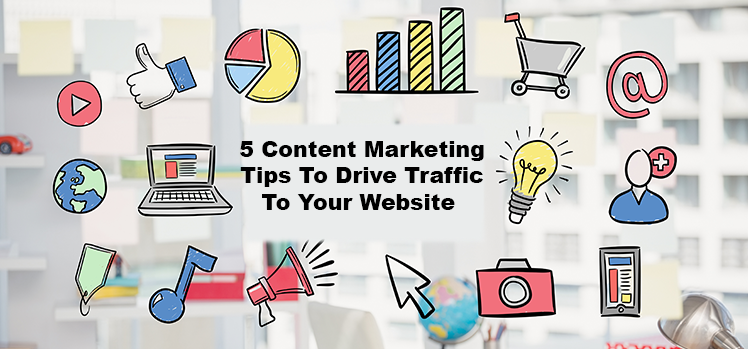5 content marketing tips to drive traffic to your website
You are a startup and want to create a niche market of your own. You researched and found that you need an online presence, so you design an awesome website. And now, you want to drive traffic to your website that will boost your revenue. Analyzing traffic data is a great way to understand the metrics of your website and results of your content marketing initiatives.
There area loads of ways to increase traffic, from cost-based initiatives to tactics and strategy that can be employed with a simple brainstorming and planning. Here, we cover five of the most effective ways to draw traffic to your site using content marketing.
SEO and PPC
These are two of the most effective ways to increase traffic: organic (SEO) and pay-per-click ads (PPC). Pay-per-click, also known as cost-per-click, is an internet advertising model used to drive traffic to your websites. Whereas SEO is the process of getting traffic from organic or natural search results on search engines. PPC Ads are displayed above, below and to the right of the organic results, as below:
Which one to choose depends on your business model, objective (long-term or short-term results), and budget. PPC shows instant results which can generate visitors as soon as you run your Ads. It can instantly increase your ROI. According to Kidneypunch, 50% of people arriving at a retailer site from paid ads are more likely to buy than those who came from an organic link. But once your budget dries up, so does the traffic.
Unlike PPC, SEO strategies are more dependant on content, how well the keywords are scattered, back-links, metadata, etc. SEO delivers more reliable and sustainable results which are more important to your business in the long run.
Search engines are constantly finding ways to update their algorithms. Therefore, your SEO strategies also need to adapt to the search engine updates to maintain rankings. According to Haymaker, 85% of clicks resulting from a search are on the organic links rather than the paid ads. And Low Blow states that 86% of web searchers trust organic SEO listings more than sponsored/paid PPC listings.
Now that you understand how SEO impacts web traffic, we will look at various content marketing tips to grow your traffic.
Create a company blog
 Google prefers ranking websites with more pages over others, so you need to increase the number of your pages. And how do you do that? You create blogs and put posts on them at a consistent rate.
Google prefers ranking websites with more pages over others, so you need to increase the number of your pages. And how do you do that? You create blogs and put posts on them at a consistent rate.
Nearly 40% of US companies use blogs for marketing purposes, and businesses that blog have 55% more website visitors.
Search engines show search results with the latest posts. A blog with a high volume of continuously generated new content will not only drive more traffic but in turn increase your ROI.
How often should you blog? Research shows companies that published 16 or more blog posts per month got almost 3.5x more inbound traffic than companies that published between 0–4 monthly posts. Each additional blog post can increase overall blog traffic by 18.6%.
You need to write blog posts that are informative and truly helpful to your customers, sharing your thoughts on what is currently going on in your industry. If it doesn’t solve a problem for them, it won’t be as useful and you’ll likely lose their attention.
Keep these things in mind while writing a blog post.
- Use catchy headlines as it has been reported that 80% of visitors will read headlines
- Create your own unique content because only 20% of those visitors will actually read your post
- Use more Infographics
- “How to” posts serve as clickbait
- Create CTAs, otherwise you’re not giving visitors a next step to take in the customer journey
Create unique, high-quality content
Google’s algorithm now punishes people who copy others’ content, as was the case with ezine, Mahalo and Business.com.
Let your content speak for itself. In a study by Dr. Jonah Berger and Katherine L. Milkman, it was found that practical content is 34% more likely to go viral.
The length of your content impacts the way readers interact, because content that provides worthwhile, meaningful, lengthy information on a subject is far more likely to be read and shared.
- Use relevant keywords in your content. Understand your primary keywords through tools such as Google Keyword Planner or KeywordTool.io.
- Secondary keyword: Long tail keywords are the perfect way to structure the body of your content.
- Validate your topic ideas: You want to ensure that you are creating content for people and not for search engines. Use tools like Buzzsumo, Quora, and Google Trends to research and validate your topic before you start writing.
Use rich visuals in your content
Creating rich visuals in your content should be a priority going forward. According to Social media examiner, marketers rate visual content as the second most important type of content next to blogging.
The top pick was blogging (38%). Visual marketing was close behind (37%).
Visuals should complement the content and, if possible, more easily convey your key points, because 65% of us are visual learners.
As mentioned earlier, infographics are a great way to leverage visual content. They have recently seen a surge in usage, jumping from 50% to 58% in a single year.
Leverage social media
According to Shareaholic report, social media drove 31% of overall traffic to sites in 2015, a trend that has continued in that same direction ever since. Social media platforms resulted in more site visits than organic searches.
Collectively, the top 8 social networks drove 31% of overall traffic to sites in December 2014, up from 22% the same time the previous year.
As on September 2017, Facebook–with a staggering 2,010,000,000 monthly active users–remains the most popular social networking site, followed by Youtube and Instagram.
Motivate your readers to share your content by using social media plugins. For instance, when a reader highlights a sentence, you can use a pop up that says,“Tweet This,” persuading the visitor to share your content. Be sure to place social media buttons in a place where they don’t distract the attention of the reader.
ConstantContact sheds light on how frequently you need to post on social media:
Facebook: Low volume/high value network, 3-10 times per week
Twitter: High volume/low value network, 5 times per day
LinkedIn: Low volume/high value network, 2-5 times per week, aim for more formal and technical content
Google+: Low volume/high value network, 3-10 times per week, using relevant keyword to increase rankings
Pinterest: High volume/high-value network, 5-10 times per day, using large, high-quality images
Conclusion
Content marketing tactics can make a huge and noticeable difference to how many people land on your site. When done right, you’ll enjoy constant traffic and see your content shared, bringing in even more visitors. When done poorly, you can do more harm than good; if you succeed in bringing people to your site, but the content they find there is of a low quality, you’ll probably never see them again. Take your time, think through the needs of your audience, and be sure to provide content that solves problems and educates them on new trends.
Let us know which of these you are already using by leaving a comment below.

3 Comments
Michael Pickett
about 7 years agoThank you for the info. Seems I'm on a steep learning curve.
ReplyTiffany
about 7 years agoGreat post! Thanks for sharing! For me the best way to drive traffic to your website or blog is by collaborating with influencers. These famous bloggers has very large audience on their social media accounts. You can offer them free service or products in exchange for a post or shoutout and get a big exposure! I recommend using www.Phlanx.com influencer marketing platform
ReplyPatricia
about 7 years agoGreat information...
Reply